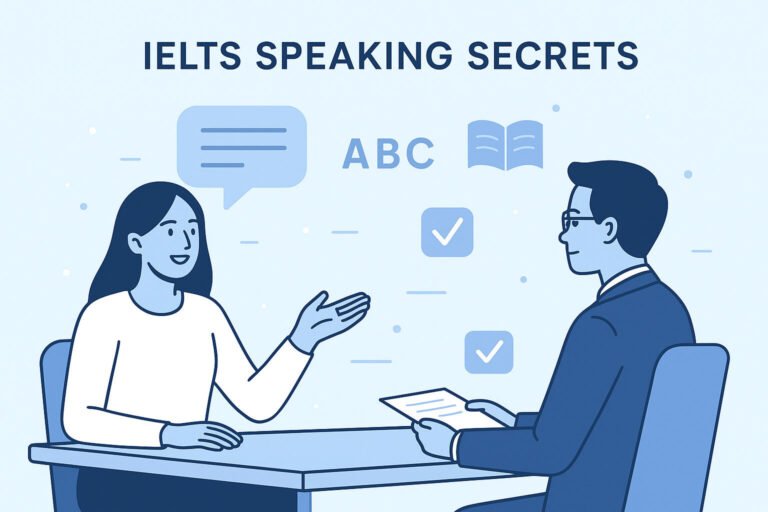Are you feeling anxious about the IELTS Speaking Part 2, where you have to speak for 1-2 minutes on a given topic? Many aspirants struggle with organizing their thoughts under pressure, but don’t worry— this guide will equip you with proven strategies to excel. Based on expert notes from an IELTS speaking class, we’ll cover essential do’s, don’ts, sample cue cards, and idioms to boost your fluency and vocabulary. By the end, you’ll be ready to deliver confident, structured responses that impress examiners and help you achieve a band 7+.
Understanding IELTS Speaking Part 2: The Basics
IELTS Speaking Part 2, often called the “long turn,” is the second section of the speaking test. The examiner gives you a cue card with a topic and bullet points to guide your talk. You get 1 minute to prepare notes, then speak for 1-2 minutes. Topics range from personal experiences to opinions on everyday matters.
This part tests your ability to speak at length, use varied language, and stay coherent. Unlike Part 1’s short answers, here you must expand ideas logically. Success comes from practice and knowing what examiners look for: fluency, lexical resource, grammatical range, and pronunciation.
Key Do’s for IELTS Speaking Part 2: Strategies to Shine
To ace the long turn, follow these do’s from class notes. They focus on preparation, structure, and delivery.
- Prepare a clear structure: Use the cue card’s bullet points as your outline. Start with an introduction, cover each point, and end with a conclusion. For example, if the topic is “Describe a memorable event,” begin with “One event that stands out in my memory is…”
- Make notes effectively in 1 minute: Jot down key words or phrases, not full sentences. Include vocabulary related to the topic, like “thrilling” for an adventure story.
- Speak for the full time: Aim for 1-2 minutes by adding details, reasons, and examples. Explain why something happened and how it made you feel to show depth.
- Use linking words for coherence: Connect ideas with phrases like “firstly,” “in addition,” “as a result,” or “to sum up.” This makes your speech flow naturally.
- Incorporate idioms and advanced vocabulary: Show off your language skills. For instance, say “It was a blessing in disguise” if describing a challenge that turned positive.
- Practice pronunciation and pace: Speak clearly at a natural speed. Record yourself to check intonation and stress on important words.
- Stay on topic: Refer back to the cue card to avoid rambling. If you stray, gently steer back with “Getting back to the point…”
These do’s will help you build a strong, engaging response. Practice with timers to simulate test conditions.
Common Don’ts in IELTS Speaking Part 2: Avoid These Mistakes
Class notes highlight pitfalls that can lower your score. Steering clear of these don’ts keeps your performance polished.
- Don’t memorize scripts: Examiners spot rehearsed answers, which hurt fluency. Instead, adapt ideas to the specific cue card.
- Don’t speak too fast or mumble: Rushing leads to errors; slowing down too much shows hesitation. Aim for a conversational pace.
- Don’t ignore the bullet points: Cover all points on the card. Skipping them can make your response incomplete.
- Don’t use repetitive words: Avoid overusing “good” or “nice.” Vary with synonyms like “excellent” or “enjoyable” for better lexical resource.
- Don’t panic if you forget something: If your mind goes blank, pause briefly and move to the next point. It’s better than filler words like “um” excessively.
- Don’t give short answers: This isn’t Part 1. Expand on each idea; a 30-second talk won’t impress.
- Don’t neglect body language: Even in online tests, sit up straight and gesture naturally to build confidence.
By avoiding these, you’ll present as a competent speaker. Remember, minor mistakes are okay if you communicate effectively.
Powerful Idioms for IELTS Speaking Part 2: Elevate Your Language
Idioms add flair to your long turn, demonstrating advanced English. From class notes, here are idioms with examples for common cue card topics.
- A piece of cake: Something easy. Example: “Learning to play the guitar was a piece of cake for me because I had a great teacher.”
- Hit the books: Study hard. Example: “Before exams, I always hit the books to prepare thoroughly.”
- Break a leg: Good luck. Example: “My friend said ‘break a leg’ before my job interview, and it went well.”
- Cost an arm and a leg: Expensive. Example: “Buying a new car cost me an arm and a leg, but it was worth it.”
- Under the weather: Feeling ill. Example: “I was under the weather during the trip, so I couldn’t enjoy it fully.”
- Burn the midnight oil: Work late. Example: “I burned the midnight oil to finish my project on time.”
- Once in a blue moon: Rarely. Example: “I eat fast food once in a blue moon because I prefer healthy meals.”
Use 2-3 idioms per response, ensuring they fit naturally. Practice saying them to improve pronunciation.
Sample Cue Card Topics and Model Answers
To make it practical, let’s look at common cue cards with model responses. These incorporate do’s, avoid don’ts, and include idioms.
Cue Card 1: Describe a Person You Admire
- Who the person is
- How you know them
- What qualities they have
- Why you admire them
Model Answer: “The person I admire most is my grandmother. She’s in her 80s and lives with my family. I know her well since childhood, as she raised me while my parents worked. She has qualities like resilience and kindness; despite facing hardships, she’s always positive. For instance, during tough times, she says it’s a blessing in disguise. I admire her because she taught me to hit the books and persevere, shaping who I am today.”
Cue Card 2: Describe a Favorite Hobby
- What the hobby is
- When you started it
- Why you enjoy it
- How it benefits you
Model Answer: “My favorite hobby is painting. I started it about five years ago during a stressful period at work. I enjoy it because it’s relaxing and lets me express creativity—it’s like a piece of cake compared to my job. It benefits me by helping me unwind; I often burn the midnight oil on canvases, which reduces stress and improves my focus.”
Use these as templates. Adapt them to your experiences for authenticity.
Timing and Preparation Tips for the Long Turn
Timing is crucial in IELTS Speaking Part 2. During preparation minute, brainstorm ideas using the WH questions: who, what, when, where, why, how.
Practice with a partner or app. Time yourself: 1 minute notes, 2 minutes speaking. Review recordings for improvements.
| Preparation Step | Time Allocation | Tips |
|---|---|---|
| Read Cue Card | 10 seconds | Understand all points |
| Brainstorm Ideas | 30 seconds | Jot keywords for each bullet |
| Organize Structure | 15 seconds | Intro, body, conclusion |
| Add Vocabulary | 5 seconds | Include 1-2 idioms |
This table helps streamline your prep. Consistent practice builds confidence.
Advanced Techniques to Boost Your Band Score
For higher bands, layer your response. Use complex sentences: “Although it was challenging, I managed to…” Vary vocabulary with topic-specific words, like “ecotourism” for travel topics.
Focus on pronunciation: Stress syllables correctly, e.g., “ad-MIRE” in “admire.” Intonation rises for questions in your narrative.
Incorporate opinions: “In my view, hobbies are essential because…” This shows critical thinking.
Common Questions About IELTS Speaking Part 2
What if I can’t think of anything during preparation?
Stay calm. Use general examples if personal ones don’t fit. The examiner values language over content accuracy.
How many idioms should I use?
1-3 per response. More can sound forced; focus on natural integration.
Can I ask the examiner to repeat the cue card?
Yes, but only if unclear. It won’t affect your score if done politely.
What topics are most common?
Personal experiences (e.g., describe a book), places, events, or objects. Practice 20-30 cue cards.








